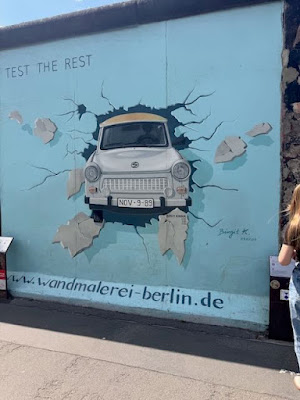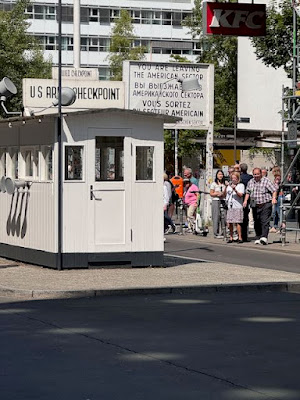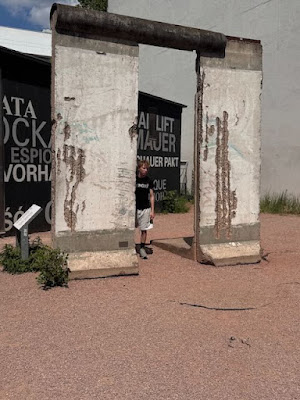Our cruise ship docked at the German port city of Warnemünde at 7 AM. We boarded a train and left the port around 9 for a 3-hour private train ride to a station in central Berlin. Our plan for the day was to explore three specific landmarks in Berlin. OFD had researched the trains we would need to take to get to our first destination, The Wall.
The Berlin Wall was a physical barrier constructed by the German Democratic Republic (East Germany) that physically and ideologically divided Berlin from 1961 to 1989. It symbolized the Cold War and the division of Europe into communist and capitalist blocs. The wall was erected to prevent East Germans from fleeing to the West, and its fall in 1989 marked a major turning point in the Cold War and the reunification of Germany. ~ AI
The original wall, built of barbed wire and cinder blocks, was subsequently replaced by a series of concrete walls (up to 15 feet high) that were topped with barbed wire and guarded with watchtowers, gun emplacements, and mines. By the 1980s that system of walls, electrified fences, and fortifications extended 28 miles through Berlin, dividing the two parts of the city, and extended a further 75 miles around West Berlin, separating it from the rest of East Germany. ~ Britannica
The East Side Gallery is the longest surviving section of the Berlin Wall. In 1990, more than 100 artists from over 20 countries decorated this stretch of the hinterland wall with their art works. ~ Visit Berlin
Once it was the Berlin Wall; today it is the longest open-air gallery in the world at 1.3 km.
Touch the Wall by Christine Kühn
There are memorials and museums that we did not see, related to the history of The Wall.
On the evening of 9 November 1989, the Berlin Wall fell. It was a night when innumerable East and West Berliners made history. They climbed over the concrete walls, crowded through the narrow border crossing points, went at the Berlin Wall with hammers, and retook their city in its entirety. The images of this historical event were shown around the world. ~ Visit Berlin
in a park, across the street, near the end of The Wall
The fall of the Wall left unused spaces in the urban landscape. Residents and visitors adopted these abandoned areas as creative spaces – from the art scene in Brunnenstraße to the Berlin start-ups at Moritzplatz – or simply enjoyed the new access to the River Spree. ~ Visit Berlin
the west side of The Wall; no graffiti that I could see
Today, more than 30 years on, Berlin is no longer a walled city, but a world city. Since those days, millions of visitors have come to Berlin, Germany’s capital city, to see this change for themselves. ~ Visit Berlin
From the area of The Wall and the museums, we took the train to Check Point Charlie.
The guard house is in the middle of the street, a busy street I might add. People were lined up to have their photo taken. (OFD made $5 for taking a photo of the two gentlemen in line in front of us!)
the line for photos
the backside of Check Point Charlie
Across the street from Check Point Charlie, was a small park and a couple of sections of The Wall, and a geocache.
Between 1961 and 1989, the East German government changed the design of the barrier four times along many sections of the border strip.
"Border Wall 75" was erected from 1975-76 on.
A decision was taken to erect a construction that would form a completely insurmountable barrier.
Refugees found it almost impossible to climb over Wall model UL 12.41.
The piping along the top prevented people from pulling themselves up the Wall.
The long concrete foot pointed into the border strip, making it impossible for barrier-smashing vehicles from East Berlin to demolish sections of the Wall.
The world-famous Berlin Wall was the front barrier (facing West Berlin).
During the 1980s, the front wall would be sprayed with graffiti and
huge pictures painted on the West Berlin side.
After the Wall fell on 9 November 1989
Wall segments on the East Berlin side were painted too. ~ The Sign
This "graffitied" section of The Wall was at our next stop, food.
currywurst, which was actually quite good
although I stuck with a traditional bratwurst
Hubby had French fries
geocaching souvenir for Berlin
OFD had one more stop related to the Berlin Wall and its history:
Brandenburg Gate
The Brandenburg Gate is an 18th-century neoclassical monument in Berlin. One of the best-known landmarks of Germany, it was erected on the site of a former city gate that marked the start of the road from Berlin to Brandenburg an der Havel, the former capital of the Margraviate of Brandenburg.
It was built from 1788 to 1791 by orders of King Frederick William II of Prussia. ~ Wikipedia
(Berlin had 18 gates leading to the city. The Brandenburg Gate is the only one remaining today.)
When the Revolutions of 1989 occurred and the wall was demolished, the gate symbolized freedom and the desire to unify the city of Berlin. Thousands of people gathered at the wall to celebrate its fall on 9 November 1989. On 22 December 1989, the Brandenburg Gate border crossing was reopened when Helmut Kohl, the West German chancellor, walked through to be greeted by Hans Modrow, the East German prime minister. Demolition of the rest of the wall around the area took place the following year. ~ Wikipeda
It was near the Brandenburg Gate that we learned (relearned) the role Ronald Reagan played in the fall of The Berlin Wall.
Lego Giraffe
OFD also took us to Potsdamer Platz which has existed since the 18th century. The square had its heyday at the beginning of the 20th century: traffic was humming and life was bustling here. As early as 1924, the first traffic light system on the continent guided omnibuses, trams, carriages and vehicles. The cultural elite also met in the cafés and restaurants around the square. The Second World War left behind a devastated square, which then became the "border triangle" between the Soviet, British and American sectors. After the end of the war, the Berlin Wall divided the area, and so Potsdamer Platz spent more than 40 years in a deep sleep - as an urban wasteland between East and West. In 1993, in just five years, a new urban centre was created out of nothing on the largest construction site in Europe. ~ Visit Berlin
She had a museum she wanted to visit. The Lego store is in the area of Potsdamer Platz. We just waited in the area for her return, but I did notice the metal strip embedded in the plaza. The strip was a reminder that The Berlin Wall had been there just 35 years earlier.
Next: Berlin Cathedral




























No comments:
Post a Comment
Thanks for your comments!